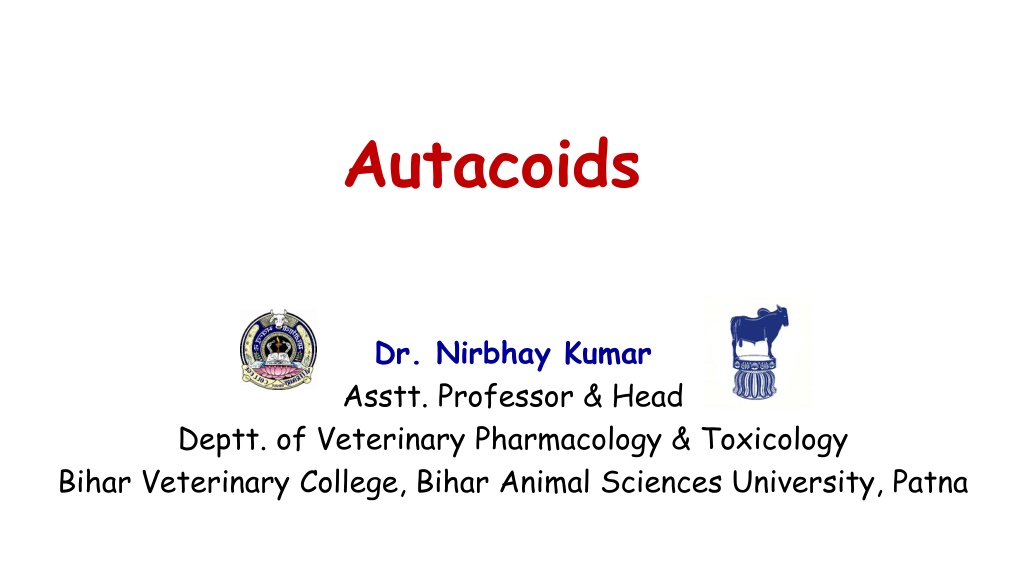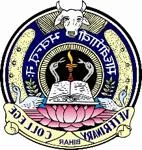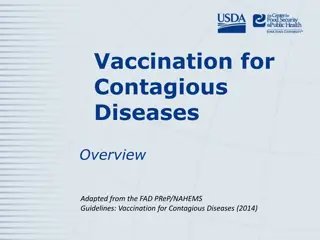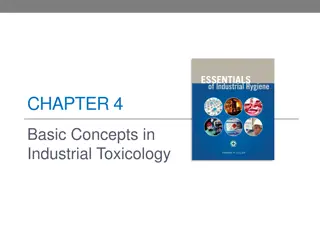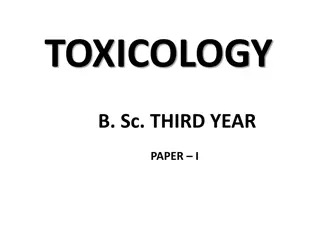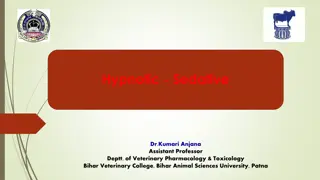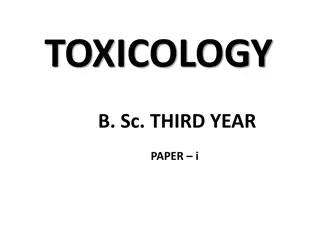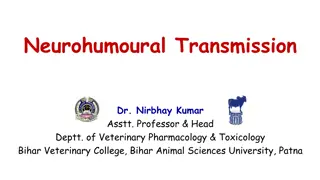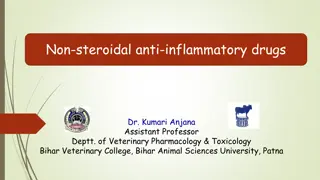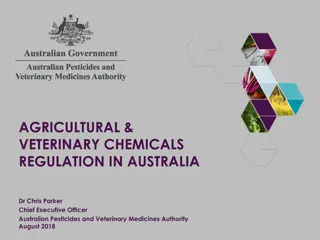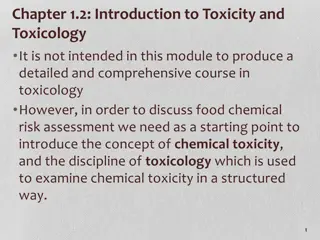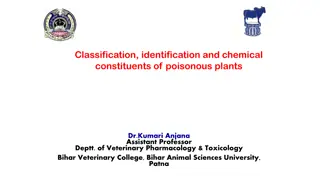Autacoids in Veterinary Pharmacology & Toxicology
Autacoids are locally acting hormone-like substances with intense biological activity produced by various cells in the body. They act briefly at the site of synthesis and release, playing roles in inflammation, vasoactivity, and more. This content delves into the classification, functions, and synthesis of autacoids, with a focus on histamine as a tissue amine.
Download Presentation

Please find below an Image/Link to download the presentation.
The content on the website is provided AS IS for your information and personal use only. It may not be sold, licensed, or shared on other websites without obtaining consent from the author.If you encounter any issues during the download, it is possible that the publisher has removed the file from their server.
You are allowed to download the files provided on this website for personal or commercial use, subject to the condition that they are used lawfully. All files are the property of their respective owners.
The content on the website is provided AS IS for your information and personal use only. It may not be sold, licensed, or shared on other websites without obtaining consent from the author.
E N D
Presentation Transcript
Autacoids Dr. Nirbhay Kumar Asstt. Professor & Head Deptt. of Veterinary Pharmacology & Toxicology Bihar Veterinary College, Bihar Animal Sciences University, Patna
Autacoids The term autacoid is derived from Greek words autos meaning self and akos meaning remedy or healing substance. Autacoids are locally acting hormone like substances produced by a wide variety of cells in the body, having intense biological activity which act briefly at the site of synthesis and release (i.e. on adjacent cells).
Autacoidscontd Autacoids are also known as tissue hormones or local hormones. These are formed, released and inactivated within tissues. They are usually vasoactive and mediators of inflammation. Autacoids differ from hormones in following ways: (i) Hormones are produced by specific cells; and (ii) They are transported through circulation to act on distant target tissues.
Classification of Autacoids (I) Classification based on chemical structure: (1)Amine autacoids: Histamine, 5-Hydroxytryptamine (5-HT) or Serotonin. (2)Lipid derived autacoids: Eicosanoids {Prostaglandins, Leucotrienes (LTs) and Thromboxanes (TXs)}, Platelet activating factor (PAF). (3)Peptide autacoids: Plasma kinins (Bradykinin and Kallidin), Angiotensin, Polypeptide (VIP) and Substance P. Vasoactive Intestinal
Classification of Autacoids contd Classification based on origin: 1. Precursor molecules in plasma: Bradykinin, Kallidin and Angiotensin. 2. Preformed & stored in the cell: Histamine, 5-HT, VIP and Substance P. 3. Precursor molecules in cell membrane phospholipids: Prostaglandins, LTs and PAF.
Histamine (Tissue Amine) It is an amine present in a variety of animal tissues, venoms, bacteria and certain plants (e.g. stinging nettle). The anaphylaxis, allergies and certain types of drug reactions, and it regulates gastric secretion. amine is involved in inflammations,
Synthesis, Storage & Catabolism of Histamine Chemically, histamine is -imidazolylethylamine. It is synthesized from the decarboxylation of amino acid histidine by a specific decarboxylase. This enzyme is present in all cell types that contain histamine. Histamine is widely distributed throughout mammalian tissues. enzyme, histidine
Synthesis, Storage & Catabolism of Histamine contd It is generally accepted that most of histamine stored within the body is synthesized locally. Dietary histamine & histamine produced by enteric bacteria are disposed off rapidly after absorption into the portal circulation and contribute little or nothing to tissue storage sites. In the animal body, histamine (basic) is found complexed with heparin (acidic) and protein in the granules of mast cells.
Catabolism of Histamine The includes ring methylation (to form N-methylhistamine) catalyzed by N-methyltransferase and oxidative deamination catalyzed by diamine oxidase (histaminase) imidazolylacetic riboside. catabolism of histamine forming and acid its The metabolites of histamine are pharmacologically inert and are excreted in urine.
Histamine Stores Mast cell pool up of Non-mast cell pool up of localized in GI tract, CNS, dermis and other organs. (ii) Fast turnover. (iii)It is synthesized and released continuously rather than being stored. Functions: CNS Neurotransmitter GIT Control secretion. (i) Resistant to histamine releasing drugs such as compound 48/80. (i) Made (connective tissue) and basophils (blood). (ii) Turnover of histamine is slow. (iii)The mast cell pool represents the histamine that participates in inflammatory allergic phenomena, shock, some adverse drug other forms of cellular insult. (iv)Effect of histamine liberating drug 48/80 complete emptying of storage granules & release of histamine. mast cells (i) Made histaminocytes responses, reactions and of gastric
Histamine Receptors H1 2-methylhistamine Chlorpheniramine Selective Agonist Selective Antagonist H2 H3 4-methylhistamine Ranitidine a-methylhistamine Thioperamide Smooth muscle (GIT, RT & uterus): Contraction. Blood vessels: Endothelium- Vasodilatation & increased capillary permeability. Smooth muscle- Vasoconstriction. Afferent nerve endings: stimulation (itching & pain) Ganglionic cell: Stimulation. Adrenal medulla: Release of catecholamines Brain: Transmitter function. Gastric glands: Acid secretion. Blood vessels: Dilatation. Heart: + ve inotropy + chronotropy Brain: Transmitter function. Brain: Inhibition of histamine release (sedation). Lung, spleen, skin, gastric mucosa: histamine content. Primarily serves as autoreceptors controlling histamine release from neurons in brain. Distribution In The Body And Actions Mediated
Pathophysiological Functions of Endogenous Histamine HCl secretion in the stomach. Released from mast cells following Ag - Ab interactions during hypersensitive reactions (Type-1 hypersensitivity). Neurotransmitter in CNS: Regulates water intake, body temperature, release of ADH, blood pressure and pain perception. Regulates GI tone and motility : helps to maintain normal peristalsis. Released in extensive tissue damage: Mediates local circulatory response to injury and inflammatory reactions. Play an essential role in the process of tissue growth and repair because these tissues contain high concentrations of histamine.
Histamine Release Various factors are responsible for release of histamine from mast cells:- 1. Tissue damage by trauma, stings, venoms, proteolytic enzymes etc. 2. Antigen antibody reactions involving IgE antibodies. 3. Some drugs like tubocurarine, morphine, atropine, polymyxin B, vancomycin etc. release histamine without an immunological reaction.
Pharmacological Effects of Histamine [1]. Blood Vessels: Marked dilatation of smaller blood vessels including arterioles, capillaries and venules. Constrictor effect on large blood vessels. In rabbits, histamine is a pressor agent as a result of pronounced constriction of blood vessels. Histamine Shock: Intense dilatation of capillary bed Increase in capillary permeability. The dilated arterioles, capillaries and venules that tag large volumes of blood and reduce venous return to heart and thus the cardiac output. Histamine release during allergic or anaphylactic reactions. The condition may cause death due to vascular shock as seen in acute surgical or haemorrhagic shock.
Pharmacological Effects of Histaminecontd Triple Response: Histamine produces a characteristic triple response in skin following intradermal injection. It consists of the following:- 1. A localized red spot : due to intense capillary dilatation developing within a few seconds and attaining maximum hue within a minute. 2. Wheal : Localized oedema fluid forming a wheal in about 90 seconds due to exudation of fluid from capillaries and venules; and 3. Flare (Diffuse redness) : i.e. redness in the surrounding area due to arteriolar dilatation mediated by axonal reflex.
Pharmacological Effects of Histaminecontd [II]. Non-vascular smooth muscles: Acute bronchial constriction (via H1 receptors) in most of the species. However, guinea pigs are exceptionally sensitive and even minute doses of histamine can evoke bronchoconstriction leading to death. Tracheal relaxation in cat (both H1 & H2), bronchial relaxation in sheep (H2) and uterine relaxation in rat (H2) but uterus is generally contracted in other species. [III]. Exocrine glands: gastric acid secretion (due to H2 receptors). [IV]. Sensory nerve endings: Nerve ending stimulation Itching & pain. [V]. Autonomic ganglia and adrenal medulla: Adrenaline release, B.P. [VI]. C.N.S.: Histamine does not penetrate blood brain barrier.
Medical Uses of Histamine Histamine has no therapeutic application, but used in experimental pharmacology. Clinical applications in human include (i) Use of histamine as a test agent for achlorhydria. (ii) Used in diagnosis of phaechromocytoma, and (iii) Used for production of triple response to evaluate integrity of sensory innervations and circulatory competency.
Antihistamines Drugs used to antagonize the effects of histamine liberation. The antihistamines act as competitive antagonists of histamine at receptor sites. The antihistamines of clinical value in veterinary medicine are H1 antagonists. H1 Antagonists: These are the drugs which competitively antagonize actions of histamine at H1 receptors. These are also known as Conventional Antihistaminics.
Classification of H1 antagonists Drug First Generation (1) Ethanolamines : Diphenhydramine HCl (2) Ethylene diamines : Pyrilamine maleate (3) Alkylamines : Chlorpheniramine maleate Pheniramine maleate (1) Piperazines : Hydroxyzine HCL (2) Phenothiazines : Promethazine HCl (3) Piperidines : Cyproheptadine HCl Trade Name Benadryl (Parke-Davis) Histosol Jeet (Alembic), Avil (Intervet) Atarax (UCB Pharma) Phenergan (Rhone Poulenc) Practin (Merind) Second Generation (1) Piperazines : Cetirizine HCl (2)Piperidines Cetzine (Glaxo) Loridin (Cadila) Allegra (Hoechst) Terin (Wockardth) : Loratadine HCl Fexofenadine HCl Terfenadine HCl
H1 antihistaminics Highly Sedative : Diphenhydramine, Promethazine & Hydroxyzine. Moderately Sedative : Pheniramine and Cyproheptadine. Mildly Sedative : Chlorpheniramine and pyrilamine Non- Sedative : Second generation antihistaminics.
H1 antihistaminics contd Cetirizine: It is a metabolite of hydroxyzine (1st generation antihistaminic) with marked affinity for peripheral H1 receptors. It penetrates blood brain barrier poorly, so is very less sedative. It attains high and longer lasting concentration in skin, which may be responsible for its superior efficacy in urticaria/ atopic dermatitis. It is indicated in upper respiratory allergies, pollinosis, urticaria and atopic dermatitis; also used as adjuvant in seasonal asthma.
H1 antihistaminics contd Cyclizine, Meclizine, Promethazine, Diphenhydramine (Anti-motion sickness): These agents have prophylactic value in milder types of motion sickness; should be taken one hour before starting journey. Promethazine can also be used in morning sickness, drug induced and post-operative vomiting, radiation sickness. H1 receptors mediate emesis in emetic centre.
H1 antihistaminics contd Clinical Uses : i. In allergic and anaphylactic reactions. ii. In bronchial asthma, laminitis, azoturia and pulmonary emphysema in horses. iii. In asthma, bloat, acetonaemia, gangrenous mastitis, metritis and retained placenta. iv. In the treatment of skin affections like dermatitis, pruritis and eczema (their mild local anaesthetic action helps in pruritis).
H2 antihistaminics These drugs block the effects of histamine that are mediated through H2 receptor stimulation, such as increase in gastric acid secretion and increase in heart rate and automaticity of auricles and ventricles. The H2 antagonists also act as competitive antagonists of histamine for H2 receptors. The H2 antagonists : Cimetidine, Ranitidine, Famotidine, Roxatidine, Nizatidine etc. These drugs are of value in the treatment of peptic ulcer in man and animals.
5-Hydroxytryptamine (5-HT) or Serotonin Serotonin was the name given to the vasoconstrictor substance which appeared in serum when blood clotted. Enteramine was the name given to the smooth muscle contracting substance present in enterochromaffin cells of gut mucosa.
Source of 5-HT 5-HT is formed and localized in three essential pools in the body: i. Enterochromaffin cells of intestine (about 90%). ii. Small number of neurons in CNS and mast cells of rodents (rat, mice, hamsters) along with histamine and heparin. iii. Blood platelets. In addition to the endogenous 5-HT reserve, it is also found in invertebrates and plants (banana, pear, pineapple, tomato, stinging nettle etc). In the pineal gland, 5-HT is converted to melatonin after acetylation and methylation.
Role of endogenous 5-HT Neurotransmitter in brain in tryptaminergic nerves. Its deficiency causes depression and excess causes excitement. It is a precursor molecule of melatonin hormone. It helps to regulate the tone and motilityof GIT. Platelet 5-HT serves as one of the mediators of blood clot formation.
Synthesis, storage and degradation of 5-HT 5-HT is synthesized from dietary tryptophan in a two stage chemical reaction:- (i) Tryptophan is hydroxylated by the enzyme tryptophan-5- hydroxylase to give 5-hydroxytryptophan (5-HTP). (ii) 5-HTP is then decarboxylated to yield 5-HT. Like catecholamines, 5-HT is also stored in storage granules and its uptake is also inhibited by Reserpine. Enzymes like MAO, dehydrogenase and aldehyde reductase help to metabolize 5-HT.
5-HT Receptors Four families of 5-HT receptors comprising of total 14 receptor subtypes:- (1)5-HT1{Five subtypes i.e. 5-HT1A, 1B, 1C, 1D, 1E}: Autoreceptors; inhibit serotonergic neural activity in brain. Functions are neural inhibition and vasoconstriction. (2)5-HT2 {Three subtypes i.e. 5-HT2A, 2B, 2C}: CNS and peripheral sites (esp. vascular and visceral smooth muscles, platelets and ANS neurons). Effects are vasoconstriction, intestinal, bronchial and uterine contraction and platelet aggregation.
5-HT Receptors contd (1)5-HT3 {No subtype}: Peripheral Nervous System Emesis, gut peristalsis, bradycardia, transient hypotension, apnoea, pain, itching etc. (2)5-HT4-7: (i) 5-HT4: (No subtype) Enteric nervous system. Mediate intestinal secretion and augments peristalsis. (ii) 5-HT5: Two subtypes i.e. 5-HT5A, 5B (iii) 5-HT6: No subtype. (iv) 5-HT7: No subtype. Not much is known about 5-HT5-7
Pharmacological effects of 5-HT [I]. C.V.S.: Vasoconstriction on major arteries and veins. Activation of 5-HT receptors in endothelial cells and local release of EDRF and prostaglandins. Triphasic Response (produced by Rapid i.v. infusion of 5-HT):- (a) An initial fall of systemic arterial B.P. accompanied by paradoxical bradycardia chemoreceptor stimulation (Bezod Jarisch Effect). (b) A short period of pressure effect; and (c) A prolonged fall in systemic B.P. attributed to a vasodilator effect in the vascular bed of skeletal muscle. caused mainly by reflex
Pharmacological effects of 5-HT contd [II]. Gastrointestinal tract (GIT): 5-HT increases motility of small intestines and inhibits the motility of stomach and large intestines. [III]. Respiratory tract (RT) and Uterus: Constriction of bronchi and uterine contraction.
5-HT Antagonists & Uses LSD, Ergot alkaloids, Methysergide, Cyproheptadine : Antiallergic and antipruritic; appetite enhancer in children and helps to gain body weight. 5-HT has negative effect on hunger centre and positive effect on growth hormone secretion), Ketanserin, Clozapine (effective in schizophrenia), Risperidone The therapeutic value of 5-HT antagonists in veterinary medicine is not yet established.
Eicosanoids (PG, PGI, TXA & LT) The biologically active substances that are derived from 20 carbon polyunsaturated fatty acids (mainly arachiodonic acid) which share a prefix eicosa (means twenty) are termed eicosanoids. These include prostaglandins (PG),prostacyclins (PGI), thromboxane (TXA) and leucotrienes (LT).
Synthesis of Eicosanoids Every cell in the body is capable of synthesizing eicosanoids. Arachiodonic acid from the phospholipids of cell membrane and tissue triglycerides by the action of the enzymes phospholipases and acylhydrolases are released for synthesis of eicosanoids. Several factors are associated with activation of these enzymes which include physiological, pharmacological and pathological stimuli. Other autacoids like angiotensin acylhydrolases and promote PG synthesis. and kinins activate
Prostaglandins Two American Gynaecologists, Kurzrok and Lieb, in 1930, reported that human semen contained a substance which was found to contract isolated uterine and other smooth muscle strips and caused a fall in blood pressure in animals. The active principle was termed prostaglandin , thinking that it was derived from prostate gland.
Classification of Prostaglandins The classification of PGs is according to substituents on the cyclopentane ring of prostaglandin molecule. Some newer PG related compounds are PGG, PGH, PGI (prostacyclin) and thromboxane. The PGs are further categorized as mono, di or triunsaturated depending on the number of double bonds in the side chains. This classification appears as a subscript to the letter. Examples are PGE1 one double bond. PGE2 two double bonds. PGE3 three double bonds.
Cyclooxygenase (COX) Metabolizes arachiodonic acid to its PG derivatives. Two major isoforms : COX-1 and COX-2. COX-1: Constitutive. Synthesizes the small amounts of PGs that participate in normal physiologic functions. Have protective actions on GI mucosa. Inhibition of COX-1 activity : Loss of GI protection of mucosal epithelial cells.
Cyclooxygenase (COX) contd COX-2: Not constitutive; rather it is inducible in nature. Bacterial lipopolysachharide and certain inflammatory cytokines & growth factors induces synthesis of COX-2. Participate in inflammatory reactions.
Other Eicosanoids Prostacyclin (PGI2): It is a potent vasodilator. Exerts antiaggregatory activity on blood platelets. PGI2 has a very brief half life of 2-3 minutes.
Other Eicosanoids contd Thromboxane A2: It is synthesized in platelets (thrombocytes). Thromboxane A2 plays an important physiological role as :- a vasoconstrictor and pro-aggregatory in thrombus formation.
Other Eicosanoids Leucotriene: It is synthesized in lung, platelets and white blood cells by metabolism of arachiodonic acid via lipoxygenase pathway. Leucotrienes are thought to be chemotactic in nature for leucocytes inflammatory responses. and participate in
Functions of Eicosanoids Prostacyclin: thromboxane A2 on blood platelets. Antagonist of prostaglandins and Prostaglandins & Prostacyclins: Promote vasodilatation and regulate tone of vasculature and control blood flow in the vital organs. TXA2: A potent vasoconstrictor.
Functions of Eicosanoids contd Prostaglandins & Leucotrienes: Released during allergic reactions and bronchoconstriction and other signs. contribute to the Prostacyclin: Controls renal blood flow, urine formation, renin secretion and checks the action of ADH.
Functions of Eicosanoids contd Prostaglandins in semen may have a role in facilitating conception following coitus. They also help in termination of pregnancy at the term. PGF2 elaborated by uterus (mare, cow, sow & ewe) functions like luteolytic hormone and used for synchronizing oestrous. Aspirin, antagonist of PGF2 inhibits uterine contractions during parturition by interfering with prostaglandin synthesis.
Functions of Eicosanoids contd PGs & LTs are produced during tissue injury are responsible for reactions of inflammations. Increase in vascular permeability, oedema and leukocyte infiltration and potentiate the pain inducing effect of bradykinin. Leucocytes release leucotrienes which help in migration of leucocytes.
Clinical Uses of Eicosanoids PGF2a analogues (Dinoprost, Tiaprost) are used for:- Oestrous synchronization (cow, ewe, goat, buffalo etc.) Induction of oestrous in anoestrous animals. Expulsion of mummified foetus; and Expulsion of pus in pyometra.
